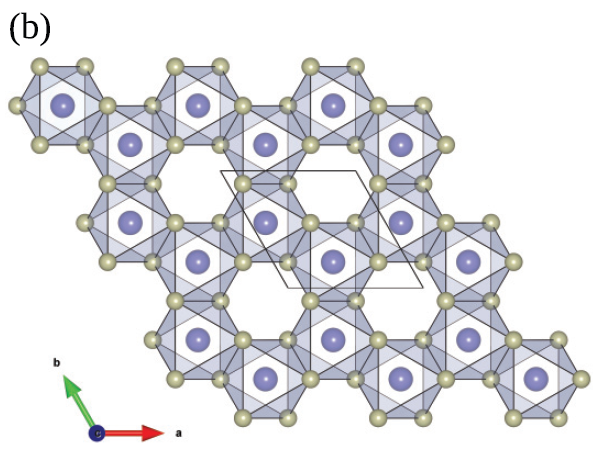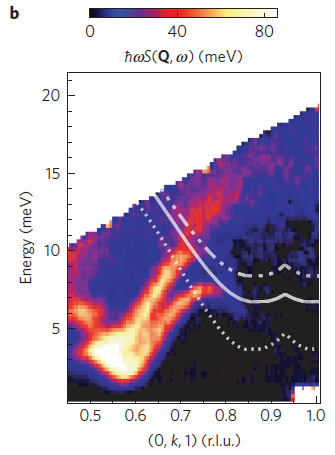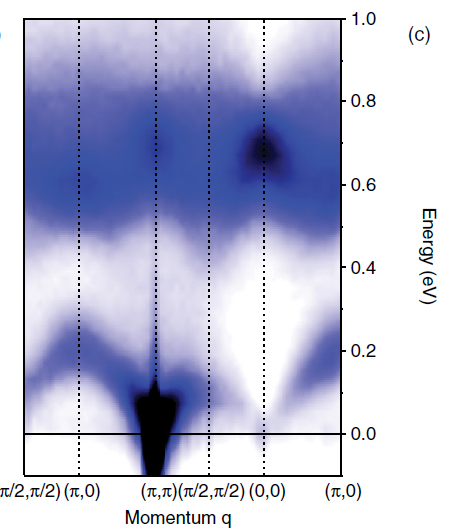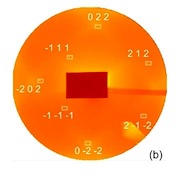Research
Research Interests
- High temperature superconductors
- Topological quantum phases in iridates
- Thermoelectric materials
- Structure of exfoliated thin nanocrystals
- Quantum magnetism in nanostructures
Recent Highlights
Kitaev physics in a-RuCl3
 Kitaev model was first proposed as an exactly solvable model with many remarkable qualities that are of interest to quantum computation. In this model, the spin on a honeycomb lattice are coupled with Ising-like interaction that depends on the spatial bond direction. This model is also interesting to quantum magnetism, since its ground state is an exactly solvable quantum spin liquid. One can think of this as another example of frustrated magnetism. However, this purely theoretical model has made a significant inroad into experimental condensed matter physics when researchers realized that Kitaev physics can be found in materials with strong spin-orbit coupling. In particular, honeycomb lattice iridates such as Na2IrO3 have been drawing much attention as the most promising platform to study quantum magnetism associated with Kitaev spin liquid. In a recent series of papers, our group proposed that alpha-RuCl3 (structure shown) is another candidate material to study Kitaev physics. (See Plumb et al. PRB 2014). Many researchers around the world are now investigating this material.
Kitaev model was first proposed as an exactly solvable model with many remarkable qualities that are of interest to quantum computation. In this model, the spin on a honeycomb lattice are coupled with Ising-like interaction that depends on the spatial bond direction. This model is also interesting to quantum magnetism, since its ground state is an exactly solvable quantum spin liquid. One can think of this as another example of frustrated magnetism. However, this purely theoretical model has made a significant inroad into experimental condensed matter physics when researchers realized that Kitaev physics can be found in materials with strong spin-orbit coupling. In particular, honeycomb lattice iridates such as Na2IrO3 have been drawing much attention as the most promising platform to study quantum magnetism associated with Kitaev spin liquid. In a recent series of papers, our group proposed that alpha-RuCl3 (structure shown) is another candidate material to study Kitaev physics. (See Plumb et al. PRB 2014). Many researchers around the world are now investigating this material.
Strongly Interacting Quasiparticles in a quantum magnet
Physicists often describe a solid as a zoo in which many different species of so-called quasiparticles  are roaming. These “virtual” particles are not real elementary particles, but they do act like one, and quasiparticles do have well-defined mass and velocity. For example, heat and sound are both transmitted by quasiparticles called phonons through our living room window. In our study, we studied a system of magnetic quasiparticles called triplons, which is attractive to physicists since they usually exist only at temperatures close to absolute zero. At such a low temperature, not many other species of quasiparticles are present, and therefore fundamental properties of quasiparticles can be studied without being bothered by other species. In our paper published in Nature Physics (Plumb et al. 2016) we reported that the interaction between these magnetic quasiparticles is unusually strong in the particular quantum magnet we studied. This turns out to be an important ingredient that allows three distinct subspecies of triplons to behave very differently. One of these decays slowly, while the second one disappears immediately. However, the third one actually tries to avoid entering the decay region altogether by altering its path and speed. The latter behaviour is quite reminiscent of a quantum mechanical phenomenon called avoided level crossing often found in atomic systems, but in this case the repulsion occurs between a quasiparticle and a region of phase space. Our study allows one to learn about how strongly interacting quasiparticles decay, and can be of general importance for understanding particle decay in other areas of physics.
are roaming. These “virtual” particles are not real elementary particles, but they do act like one, and quasiparticles do have well-defined mass and velocity. For example, heat and sound are both transmitted by quasiparticles called phonons through our living room window. In our study, we studied a system of magnetic quasiparticles called triplons, which is attractive to physicists since they usually exist only at temperatures close to absolute zero. At such a low temperature, not many other species of quasiparticles are present, and therefore fundamental properties of quasiparticles can be studied without being bothered by other species. In our paper published in Nature Physics (Plumb et al. 2016) we reported that the interaction between these magnetic quasiparticles is unusually strong in the particular quantum magnet we studied. This turns out to be an important ingredient that allows three distinct subspecies of triplons to behave very differently. One of these decays slowly, while the second one disappears immediately. However, the third one actually tries to avoid entering the decay region altogether by altering its path and speed. The latter behaviour is quite reminiscent of a quantum mechanical phenomenon called avoided level crossing often found in atomic systems, but in this case the repulsion occurs between a quasiparticle and a region of phase space. Our study allows one to learn about how strongly interacting quasiparticles decay, and can be of general importance for understanding particle decay in other areas of physics.
Probing collective magnetic excitations using x-ray
Using resonant inelastic x-ray scattering, we were able to detect collective

magnetic excitations (magnons) in Sr2IrO4. In a recent article published in Phys. Rev. Lett., we show that such collective dynamics of isospins (spin and orbital locked magnetic moments) could be measured with high energy x-ray photons. This is possible because x-ray photons can be tuned near the core level transition of iridium atoms, which increase magnetic sensitivity of the photons. This technique has been now used widely to study magnetic excitations in many interesting materials, including several iridates.
X-ray diffraction from crystals made of a few atomic layers
Graphene has garnered much interest in recent years due to its interesting physical properties and potential for applications. What is also interesting is the way the graphene samples were fabricated by the Nobel prize winners, Geim and Novoselov - the so-called scotch tape method. It turns out that one can make very thin (a few atomic layers) crystals of many other materials using this technique. One example is the thin BISCO (high temperature superconductor) samples made by Ken Burch’s group. However, due to the small size of these crystals (both laterally and thickness), it is extremely difficult to study the structure using x-rays. In collaboration with Canadian Light Source, Andreea was finally able to obtain a beautiful Laue pattern from 6nm crystals, which was recently published in Appl. Phys. Lett.
in recent years due to its interesting physical properties and potential for applications. What is also interesting is the way the graphene samples were fabricated by the Nobel prize winners, Geim and Novoselov - the so-called scotch tape method. It turns out that one can make very thin (a few atomic layers) crystals of many other materials using this technique. One example is the thin BISCO (high temperature superconductor) samples made by Ken Burch’s group. However, due to the small size of these crystals (both laterally and thickness), it is extremely difficult to study the structure using x-rays. In collaboration with Canadian Light Source, Andreea was finally able to obtain a beautiful Laue pattern from 6nm crystals, which was recently published in Appl. Phys. Lett.


